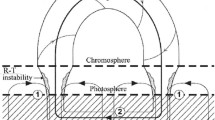Abstract
Heat fluxes from hot open magnetic flux tubes into the surrounding corona as a possible source of corona heating are determined. In order to compensate for radiation and thermal conduction losses, approximately 104 hot Type-II spicules are required, which is about 1% of the number of spicules simultaneously observed on the solar disk. It is shown that the main driver for coronal heating is the convective motion of the photosphere which creates emf. The emf supports the electric current in the Type-II spicule and the dissipation of the current in the partially ionized plasma heats the spicule to the temperature >106 K. Model of Type-II spicule as an open magnetic flux tube is discussed. The analysis shows also that Type-II spicules play an important role in the replenishing the solar corona with hot plasma.


Similar content being viewed by others
REFERENCES
Aschwanden, M.J., Physics of the Solar Corona. An Introduction with Problems and Solutions, Springer, 2005.
Braginskii, S.I., Transport processes in a plasma, in Reviews of Plasma Physics, Leontovich, M.A., Ed., New York: Consultants Bureau, 1965, pp. 205–311.
De Pontieu, B., McIntosh, S., Hansteen, V.H., et al., A tale of two spicules: The impact of spicules on the magnetic chromosphere, Publ. Astron. Soc. Jpn., 2007, vol. 59, pp. 655–S662. https://doi.org/10.1093/pasj/59.sp3.S655
De Pontieu, B., McIntosh, S.W., Carlsson, M., et al., The origin of hot plasma in the solar corona, Science, 2011, vol. 331, pp. 55–58. https://doi.org/10.1126/science.1197738
De Pontieu, B., Carlsson, M., Rouppe van der Voort, L.H.M., et al., Ubiquitous torsional motions in type II spicules, Astrophys. J. Lett., 2012, vol. 752, pp. L12–L17. https://doi.org/10.1088/2041-8205/752/1/L12
De Pontieu, B., De Moortel, I., Martínez-Sykora, J., and McIntosh, S.W., Observations and numerical models of solar coronal heating associated with spicules, Astrophys. J. Lett., 2017, vol. 845, pp. L18–L24. https://doi.org/10.3847/2041-8213/aa9272
Goodman, M.L., Acceleration of type II spicules in the solar chromosphere, Astrophys. J., 2012, vol. 757, pp. 188–195. https://doi.org/10.1088/0004-637X/757/2/188
Hood, A.W., Coronal heating, Lect. Notes Phys., 2010, vol. 793, pp. 109–160. https://doi.org/10.1007/978-3-642-02289-0_4
Kuperus, M., Ionson, J.A., and Spicer, D.S., On the theory of coronal heating mechanisms, Ann. Rev. Astron. Astrophys., 1981, vol. 19, pp. 7–40. https://doi.org/10.1146/annurev.aa.19.090181.000255
Landau, L.D. and Lifshitz, E.M., Fluid Mechanics, New York: Pergamon, 1987.
Martínez-Sykora, J., Hansteen, V., and Moreno-Insertis, F., On the origin of the type II spicules: Dynamic 3D MHD simulations, Astrophys. J., 2011, vol. 736, pp. 9–21. https://doi.org/10.1088/0004-637X/736/1/9
Murawski, K. and Zaqarashvili, T.V., Numerical simulations of spicule formation in the solar atmosphere, Astron. Astrophys., 2010, vol. 518, pp. A8–A16. https://doi.org/10.1051/0004-6361/201014394
Noyes, R.W., The Sun, Our Star, Harvard University Press, 1982.
Parker, E.N., Topological dissipation and the small-scale fields in turbulent gases, Astrophys. J., 1972, vol. 176, pp. 499–510. https://doi.org/10.1086/151512
Pereira, T.M.D., De Pontieu, B., Carlson, M., et al., An interface region imaging spectrograph: First view on solar spicules, Astrophys. J. Lett., 2014, vol. 729, pp. L15–L20. https://doi.org/10.1088/2041-8205/792/1/L15
Peter, H., Bingert, S., Klimchuk, J.A., et al., Structure of solar coronal loops: From miniature to large-scale, Astron. Astrophys., 2013, vol. 556, pp. A104–A116.
Priest, E.R., Solar Magnetohydrodynamics, Dordrecht: Reidel, 1982.
Roberts, B., Spicules: The resonant response to granular buffeting? Sol. Phys., 1979, vol. 61, pp. 23–34. https://doi.org/10.1007/BF00155443
Schmelz, J.T., Saar, S.H., DeLuca, E.E., et al., Hinode X‑ray telescope detection of hot emission from quiescent active regions: A nanoflare signature? Astrophys. J. Lett., 2009, vol. 693, L131–L135. https://doi.org/10.1088/0004-637X/693/2/L131
Sen, H.K. and White, M.L., A physical mechanism for the production of solar flares, Sol. Phys., 1972, vol. 23, pp. 146–154. https://doi.org/10.1007/BF00153898
Spicer, D.S., Heating by field aligned dc joule dissipation, in Mechanisms of Chromospheric and Coronal Heating: Proc. Int. Conf., Heidelberg (5–8 June 1990), Ulmschneider, P., Priest, E.R., and Rosner, R., Eds., Berlin: Springer, 1991, pp. 547–555.
Stepanov, A.V. and Zaitsev, V.V., Magnitosfery aktivnykh regionov Solntsa i zvezd (Magnetospheres of Active Regions of the Sun and Stars, Moscow: Fizmatlit, 2018. Takeuchi, A. and Shibata, K., Solar photospheric magnetic reconnection, Earth Planets Space, 2001, vol. 53, pp. 605–609. https://doi.org/10.1186/BF03353278
Testa, P. and Reale, F., Hinode/EIS spectroscopic validation of very hot plasma images with SDO in non-flaring active region cores, Astrophys. J. Lett., 2012, vol.750, pp. L10–L14. https://doi.org/10.1088/2041-8205/750/1/L10
Zaitsev, V.V. and Kislyakova, K.G., Plasma heating during the parametric excitation of acoustic waves in coronal magnetic loops, Astron. Rep., 2010, vol. 54, pp. 367–373. https://doi.org/10.1134/S1063772910040086
Zaitsev, V.V. and Kronshtadtov, P.V., Coronal loops heating in the atmosphere of the AD Leo Red Dwarf, Radiophys. Quantum Electron., 2016, vol. 59, pp. 169–176. https://doi.org/10.1007/s11141-016-9687-5
Zaitsev, V.V. and Shibasaki, K., Dissipation of diamagnetic currents and plasma heating in coronal magnetic loops, Astron. Rep., 2005, vol. 49, pp. 1009–1017. https://doi.org/10.1134/1.2139817
Zaitsev, V.V., Stepanov, A.V., and Kronshtadtov, P.V., On the possibility of heating the solar corona by heat fluxes from coronal magnetic structures, Sol. Phys., 2020, vol. 295, pp. 166–180. https://doi.org/10.1007/s11207-020-01732-x
Funding
This study was funded by the Russian Science Foundation projects no. 20-12-00268 (Section 3), by grants of the Russian Foundation for Basic Research no. 20-02-00108 (Section 5), no. 19-02-00704 (Section 4), as well as the State Assignments nos. 0030-2021-0002, and 1021032422589-5 (Sections 1, 2, and 6).
Author information
Authors and Affiliations
Corresponding author
Ethics declarations
The authors declare that they have no conflicts of interest.
Rights and permissions
About this article
Cite this article
Zaitsev, V.V., Stepanov, A.V. & Kronshtadtov, P.V. Type-II Spicules as Important Sources of Both Heating and Sustain the Mass Loss of Solar Corona. Geomagn. Aeron. 61, 1116–1121 (2021). https://doi.org/10.1134/S0016793221080235
Received:
Revised:
Accepted:
Published:
Issue Date:
DOI: https://doi.org/10.1134/S0016793221080235




